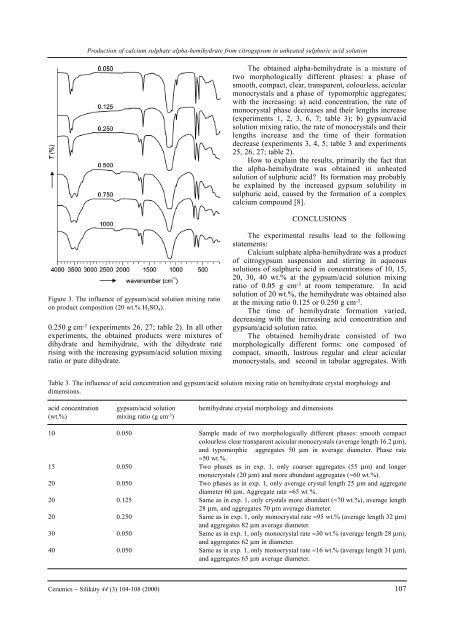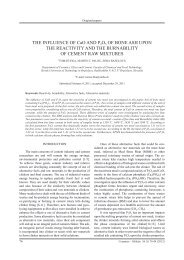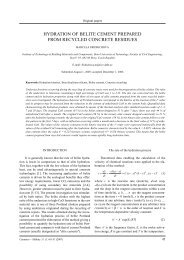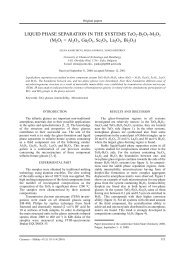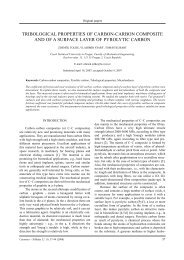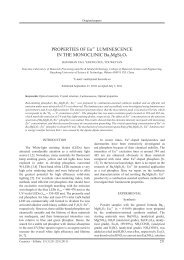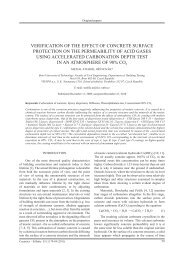Production of calcium sulphate alpha-hemihydrate - Ceramics-Silikaty
Production of calcium sulphate alpha-hemihydrate - Ceramics-Silikaty
Production of calcium sulphate alpha-hemihydrate - Ceramics-Silikaty
Create successful ePaper yourself
Turn your PDF publications into a flip-book with our unique Google optimized e-Paper software.
<strong>Production</strong> <strong>of</strong> <strong>calcium</strong> <strong>sulphate</strong> <strong>alpha</strong>-<strong>hemihydrate</strong> from citrogypsum in unheated sulphuric acid solution<br />
Figure 3. The influence <strong>of</strong> gypsum/acid solution mixing ratio<br />
on product composition (20 wt.% H 2SO 4).<br />
0.250 g cm -3 (experiments 26, 27; table 2). In all other<br />
experiments, the obtained products were mixtures <strong>of</strong><br />
dihydrate and <strong>hemihydrate</strong>, with the dihydrate rate<br />
rising with the increasing gypsum/acid solution mixing<br />
ratio or pure dihydrate.<br />
The obtained <strong>alpha</strong>-<strong>hemihydrate</strong> is a mixture <strong>of</strong><br />
two morphologically different phases: a phase <strong>of</strong><br />
smooth, compact, clear, transparent, colourless, acicular<br />
monocrystals and a phase <strong>of</strong> typomorphic aggregates;<br />
with the increasing: a) acid concentration, the rate <strong>of</strong><br />
monocrystal phase decreases and their lengths increase<br />
(experiments 1, 2, 3, 6, 7; table 3); b) gypsum/acid<br />
solution mixing ratio, the rate <strong>of</strong> monocrystals and their<br />
lengths increase and the time <strong>of</strong> their formation<br />
decrease (experiments 3, 4, 5; table 3 and experiments<br />
25, 26, 27; table 2).<br />
How to explain the results, primarily the fact that<br />
the <strong>alpha</strong>-<strong>hemihydrate</strong> was obtained in unheated<br />
solution <strong>of</strong> sulphuric acid? Its formation may probably<br />
be explained by the increased gypsum solubility in<br />
sulphuric acid, caused by the formation <strong>of</strong> a complex<br />
<strong>calcium</strong> compound [8].<br />
CONCLUSIONS<br />
The experimental results lead to the following<br />
statements:<br />
Calcium <strong>sulphate</strong> <strong>alpha</strong>-<strong>hemihydrate</strong> was a product<br />
<strong>of</strong> citrogypsum suspension and stirring in aqueous<br />
solutions <strong>of</strong> sulphuric acid in concentrations <strong>of</strong> 10, 15,<br />
20, 30, 40 wt.% at the gypsum/acid solution mixing<br />
ratio <strong>of</strong> 0.05 g cm -3 at room temperature. In acid<br />
solution <strong>of</strong> 20 wt.%, the <strong>hemihydrate</strong> was obtained also<br />
at the mixing ratio 0.125 or 0.250 g cm -3 .<br />
The time <strong>of</strong> <strong>hemihydrate</strong> formation varied,<br />
decreasing with the increasing acid concentration and<br />
gypsum/acid solution ratio.<br />
The obtained <strong>hemihydrate</strong> consisted <strong>of</strong> two<br />
morphologically different forms: one composed <strong>of</strong><br />
compact, smooth, lustrous regular and clear acicular<br />
monocrystals, and second in tabular aggregates. With<br />
Table 3. The influence <strong>of</strong> acid concentration and gypsum/acid solution mixing ratio on <strong>hemihydrate</strong> crystal morphology and<br />
dimensions.<br />
acid concentration gypsum/acid solution <strong>hemihydrate</strong> crystal morphology and dimensions<br />
(wt.%) mixing ratio (g cm -3 )<br />
10 0.050 Sample made <strong>of</strong> two morphologically different phases: smooth compact<br />
colourless clear transparent acicular monocrystals (average length 16.2 µm),<br />
and typomorphic aggregates 50 µm in average diameter. Phase rate<br />
≈50 wt.%.<br />
15 0.050 Two phases as in exp. 1, only coarser aggregates (55 µm) and longer<br />
monocrystals (20 µm) and more abundant aggregates (≈60 wt.%).<br />
20 0.050 Two phases as in exp. 1, only average crystal length 25 µm and aggregate<br />
diameter 60 µm. Aggregate rate ≈65 wt %.<br />
20 0.125 Same as in exp. 1, only crystals more abundant (≈70 wt.%), average length<br />
28 µm, and aggregates 70 µm average diameter.<br />
20 0.250 Same as in exp. 1, only monocrystal rate ≈95 wt.% (average length 32 µm)<br />
and aggregates 82 µm average diameter.<br />
30 0.050 Same as in exp. 1, only monocrystal rate ≈30 wt.% (average length 28 µm),<br />
and aggregates 62 µm in diameter.<br />
40 0.050 Same as in exp. 1, only monocrystal rate ≈16 wt.% (average length 31 µm),<br />
and aggregates 65 µm average diameter.<br />
<strong>Ceramics</strong> − Silikáty 44 (3) 104-108 (2000) 107


